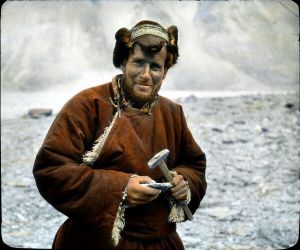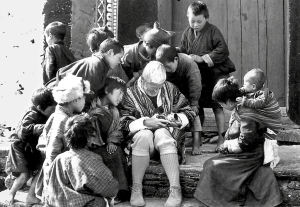 |
| Augusto Gansser (by Vera Markus) |
Augusto Gansser is to the Himalaya, what James Cook is to the Pacific Ocean, and John Wesley Powell is to the American West. While none of these men were the first to explore these regions of the world the impact these men left will continue to influence the way we see the regions they explored. Gansser is in my opinion the epitome of a traveling geologist. As a young boy, Augusto found a large quartz crystal amongst the rubble near a rail line. This piece of quartz became a symbol of Gansser’s lifelong passion for geology and discovery and was kept proudly on display until the end of his life. Some of Gansser’s geologic exploits included getting stuck in the sea ice near Greenland, Amazonian’s attacking his jeep with blow darts, smuggling Colombian emeralds in his son’s diaper, and crossing the Tibetan border at the threat of execution. Gansser also published his research prolifically throughout his life. His magnum opus Geology of the Himalayas has been cited 1850 times since 1964.
Gansser is known by most as the Father of the Himalaya (or Baba Himalaya). In June 1936, Gansser disguised himself as a Buddhist monk and snuck across the Tibetan border to investigate the geology around the holy mountain of Kailash. When he crosses government checkpoints he would bow his head to hide his blue eyes and mumble a Buddhist prayer to blend in. Mount Kailash is considered sacred in the five main religions of the area: Ayyavazhi, Buddhism, Hinduism, Jainism, and Bönism. During his sneaky expedition, Gansser discovered that although uplifted to over 6600 meters, Mount Kailash is comprised of nearly 2000 meters of undeformed sediments adjacent to the ophiolites of the Yarlung-Tsangpo Suture. Because the mountain is considered so sacred he had to photograph the mountain while hiding behind a rock Gansser was the first geologist to determine that this suture represented the boundary between India and Asia. Gansser’s early work in the Himalaya along with that of his colleague Alfred Heim was integral in the developing theories of plate tectonics.
 |
| Dressed as Buddhist pilgrim, Gansser snuck into Tibet (from Wikipedia) |
He was an incredibly successful wildcat oil prospector in Colombia and Iran for many years before returning to academia. Upon his return he immediately went back to the Himalaya, this time to Bhutan, where he was the first geologist to survey the country. Following his three expeditions to Bhutan he authored the book Geology of the Bhutan Himalaya, which is still used today as the definitive guidebook for geologists new to the area. His work in Bhutan was also integral in helping the Bhutanese understand the risks associated with catastrophic collapse of glacial lakes and dispelling myths of evil spirits punishing the people with floods.
Gansser lived to the ripe old age of 101 and remained active and healthy to the end of his life. When asked about his longevity he would pull out an old cloth bag and quip, “Near Mount Kailash, the lama in charge of the monastery where I was gave me some pills for a long life. I’m grateful to them to this day, because it seems that they have worked really well.”
Near the end of his life he stated, “I am not superstitious, but somewhere exists something greater. I have no fear of death; when it comes, it comes. Instead of flowers I would like a geologist’s hammer.” In January 2012 he was cremated in Lugano, Switzerland — with his hammer.
 |
| Photo of Mount Kailash taken by Gansser in 1936 (from ETHZ) |
 |
| Gansser in Bhutan (from AS Verlag) |
![]() This work is licensed under a Creative Commons Attribution-NonCommercial-ShareAlike 4.0 International License.
This work is licensed under a Creative Commons Attribution-NonCommercial-ShareAlike 4.0 International License.
